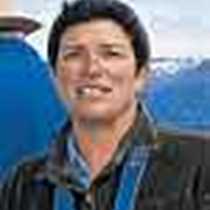Isla San Francisco
During the night, the National Geographic Sea Lion was carried south by a northerly swell. By morning’s light we were sailing into the San Jose Channel which is flanked by the Baja peninsula to the west and Isla San Jose to the east. The recent rains were apparent in the greened hillsides and arroyos.
After breakfast, all eyes were focused on the water and air looking for wildlife. Our search rewarded us with a brief encounter with a red-billed tropicbird winging by, delicate tail feathers trailing behind, and soon thereafter a school of flying fish, known to be the favored prey of the tropicbird, skimming and skipping over the water.
Late in the morning we arrived at Isla San Francisco, a small island just to the south of Isla San Jose. Isla San Francisco has a large half moon bay on its west side which today provided a wonderful anchorage where we were able to snorkel, kayak and hike. Along the north end of the bay, large volcanic rocks had spilled into the water providing perfect real estate for many fish. Snorkelers kicked through large schools of sardines. Above the water was everyone’s favorite: the guineafowl puffer dressed in its favored spotted plumage. Kayakers also explored the island’s edge where sandpipers fed and pelicans lounged around, resting before their next meal. On land we explored the island’s cactus gardens and dramatic ridges. Prickly pears bloomed, bringing bright color to the green desert.
On the east side of the island is a rocky tidal zone that we explored for creatures resplendent with spines, slime and other intertidal accessories. Deep black brittle stars, thick-spined pencil urchins and sea cucumbers were passed around for quick inspection before returning to their rocky residences.
During the night, the National Geographic Sea Lion was carried south by a northerly swell. By morning’s light we were sailing into the San Jose Channel which is flanked by the Baja peninsula to the west and Isla San Jose to the east. The recent rains were apparent in the greened hillsides and arroyos.
After breakfast, all eyes were focused on the water and air looking for wildlife. Our search rewarded us with a brief encounter with a red-billed tropicbird winging by, delicate tail feathers trailing behind, and soon thereafter a school of flying fish, known to be the favored prey of the tropicbird, skimming and skipping over the water.
Late in the morning we arrived at Isla San Francisco, a small island just to the south of Isla San Jose. Isla San Francisco has a large half moon bay on its west side which today provided a wonderful anchorage where we were able to snorkel, kayak and hike. Along the north end of the bay, large volcanic rocks had spilled into the water providing perfect real estate for many fish. Snorkelers kicked through large schools of sardines. Above the water was everyone’s favorite: the guineafowl puffer dressed in its favored spotted plumage. Kayakers also explored the island’s edge where sandpipers fed and pelicans lounged around, resting before their next meal. On land we explored the island’s cactus gardens and dramatic ridges. Prickly pears bloomed, bringing bright color to the green desert.
On the east side of the island is a rocky tidal zone that we explored for creatures resplendent with spines, slime and other intertidal accessories. Deep black brittle stars, thick-spined pencil urchins and sea cucumbers were passed around for quick inspection before returning to their rocky residences.



